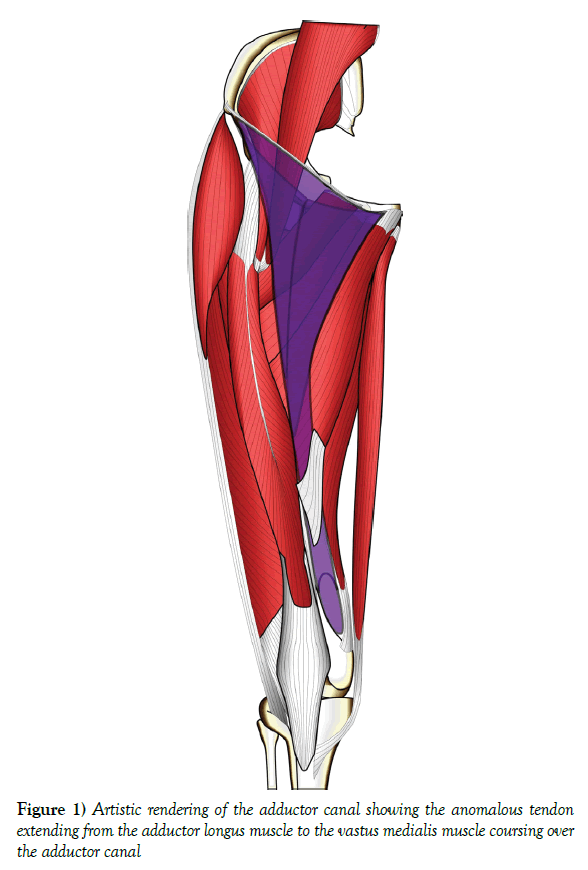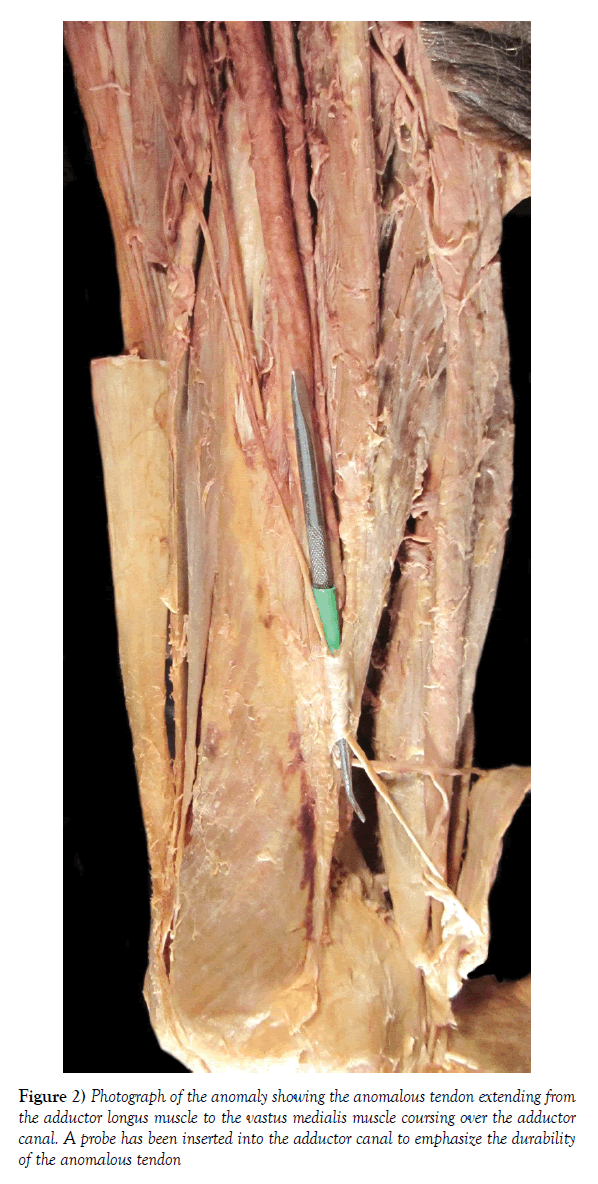Anomalous tendinous contribution to the adductor canal by the adductor longus muscle
Received: 22-Nov-2017 Accepted Date: Dec 06, 2017; Published: 11-Dec-2017
Citation: Boydstun DS, Pfeiffer JF, Persaud CC, et al. Anomalous tendinous contribution to the adductor canal by the adductor longus muscle. Int J Anat Var. 2017;10(4): 83-84.
This open-access article is distributed under the terms of the Creative Commons Attribution Non-Commercial License (CC BY-NC) (http://creativecommons.org/licenses/by-nc/4.0/), which permits reuse, distribution and reproduction of the article, provided that the original work is properly cited and the reuse is restricted to noncommercial purposes. For commercial reuse, contact reprints@pulsus.com
Abstract
Introduction: Classically the adductor canal is made from the fascial contributions from sartorius, adductor longus, adductor magnus and vastus medialis muscles. The contents of the adductor canal include femoral artery, femoral vein, and saphenous nerve. While the femoral artery and vein continue posteriorly through the adductor hiatus, the saphenous nerve travels all the way through the adductor canal and exits the inferior opening of the adductor canal.
Methods: During routine dissection, one specimen was found to have an abnormal tendinous contribution to the adductor canal.
Results: This tendon arose from the distal portions of adductor longus and created part of the roof of the canal.
Conclusions: The clinical consequences of such an anomaly may include conditions such as saphenous neuritis, adductor canal compression syndrome, as well as paresthesias along the saphenous nerve distribution.
Keywords
Adductor Canal; Anomalous tendon; Compressions syndrome; Saphenous neuralgia
Introduction
The adductor canal is a cone shaped tunnel between the anterior and medial compartments of the thigh through which the femoral artery, femoral vein, and saphenous nerve travel in the distal thigh [1-3]. It is bordered anteromedially by the vastoadductor membrane and the Sartorius muscle, anterolaterally by the vastus medialis muscle, and posteriorly by the adductor longus and adductor magnus muscles [3]. A fascial band called the vastoadductor membrane arises from the medial intramuscular septum to form the roof of the adductor canal [4]. While the femoral artery and femoral vein continue posteriorly and exit the adductor hiatus as the popliteal artery and popliteal vein, the saphenous nerve splits into the infrapatellar branch and the sartorial branch [5-7]. The sartorial branch pierces the fascia of the distal adductor canal and continues its path along the medial aspect of the leg [5,8-10] It is at this distal point that we found an abnormal fibrotendinous insertion of the adductor longus muscle forming part of the roof of the adductor canal.
Methods
During routine cadaveric dissection at the Kansas City University of Medicine and Biosciences, an anomalous tendinous insertion of the adductor longus muscle was observed on a 74 year old male cadaver. The anomaly was photographed and documented.
Results
This tendinous contribution was distinctly different from the normal, fascial anatomy of the adductor canal. The tendon arose from the distal portion of the adductor longus muscle and inserted on the tendinous portion of the vastus medialis muscle. The proximal edge of the tendon measured 7.2 mm and the inferior edge measured 7.4 mm. The width of the tendon was 32.3 mm (Figures 1 and 2). The saphenous nerve passed through the tunnel created by this tendinous roof. The sartorial branch of the saphenous nerve pierced the roof of this tunnel and continued its course down the medial aspect of the leg. This band is distinct and separate from the classically described anatomy of the adductor canal.
Discussion
Saphenous neuritis, neuralgia and adductor canal compression syndrome are commonly missed diagnoses of medial knee pain, parethesias along the course of the distal saphenous nerve, and leg claudication [1,5,8-12]. These syndromes are most commonly seen in young athletes and endurance runners [12]. The most common location for saphenous nerve compression is at the distal adductor canal where the sartorial branch pierces the roof [13,14]. This compression may be caused by an increased valgus knee angle during muscle fatigue causing there to be added tension on the nerve [14]. Additionally, compressive or traumatic injury can cause inflammation of the saphenous nerve at this location and entrapment by the adductor canal [15-18]. Symptoms of saphenous neuralgia and neuritis include medial knee pain, parethesias down the medial leg, and conduction disturbances. Patients often report an exacerbation of these symptoms while walking or climbing stairs [19]. These symptoms can be explained by wallerian degeneration occurring proximal and distal to the site of insult [18]. An injury of this nature is usually managed by conservative treatments initially with surgical intervention reserved for extreme or persistent cases [11].
Adductor canal compression syndrome causing leg claudication is most often caused by compression of the popliteal artery and vein as they exit the adductor canal through the adductor hiatus [12,15] Unlike atherosclerotic claudication syndromes, which occur overwhelmingly in the elderly population, adductor canal compression syndrome occurs in young athletes, particularly just after exercise [12,16]. Symptoms include worsening leg pain, numbness, and disappearance of pulses distal to the adductor canal upon physical activity [12]. The most common cause of this syndrome is compression of the vessels by the adductor tendon forming the adductor hiatus [3].
However, there have been a few isolated cases of a similar fibrotendinous band being found and severed during surgical exploration of individuals with chronic symptoms [12,13]. These surgical findings lead us to believe that the presence of such an anomaly places an individual at an increased risk of establishing one or both of the discussed syndromes. It is possible that this abnormality might be an explanation for young, non-athletes complaining of medial knee pain and leg claudication as well as athletes who suffer from chronic symptoms unresponsive to conservative treatments.
REFERENCES
- de Oliveira F, RB de Vasconcellos Fontes, Josemberg da Silva Baptista, et al. The connective tissue of the adductor canal--a morphological study in fetal and adult specimens. J Anat. 2009;214:388-95.
- De Souza RR, Ferraz de Carvalho CA, König Júnior B. Anatomia Topográfica do canal adutor: forma, limites e constituição de suas paredes. Rev Paul Med. 1978;92:6-9.
- Balaji MR, DeWeese JA. Adductor canal outlet syndrome. JAMA. 1984;245:167-70.
- Lumsden DB, Kalenak A. The saphenous nerve: an external method for identifying its exit from the adductor canal. Orthopaedic Review 1993;22:451-5.
- Morganti CM, McFarland EG, Cosgarea AJ. Saphenous neuritis: a poorly understood cause of medial knee pain. J Am Acad Orthop Surg. 2002;10:130-7.
- Kalenak A. Saphenous nerve entrapment. Operative Techniques in Sports Medicine 1996;4:40-5.
- Hollinshead WH. Anatomy for surgeons, in The Back and Limbs. Philadelphia. 1995.
- Kopell HP, Thompson WA. Knee pain due to saphenous-nerve entrapment. N Engl J Med. 1960;263:351-53.
- Mozes M, Ouaknine G, Nathan H. Saphenous nerve entrapment simulating vascular disorder. Surgery 1975;77:299-303.
- Romanoff ME, Cory PC, Kalenak A, et al. Saphenous nerve entrapment at the adductor canal. Am J Sports Med 1989;17:478-81.
- Worth RM, Kettelkamp DB, Defalque RJ, et al. Saphenous nerve entrapment: A cause of medial knee pain. Am J Sports Med. 1984;12:80-1.
- Verta MJ, Vitello J, Fuller J. Adductor Canal Compression Syndrome. Arch Surg. 1984;119:345-6.
- Tubbs RS, Loukas M, Shoja MM, et al. Anatomical and potential clinical significance of the vastoadductor membrane. Surg Radiol Anat. 2007;29:569-73.
- Settergren R. Conservative management of a saphenous nerve entrapment in a female ultra-marathon runner. J Bodywork & Movement Therapies. 2013;17:297-301.
- Bernhard VM. Pathology of atherosclerosis, in Rutherford :Vascular Surgery. Philadelphia. 1977;PP:488-9.
- Learmonth JR, Blackwood W, Richards RL. Localised arterial thrombosis of indeterminate origin. Edinburgh Med J. 1944;51:1-20.
- Wartenberg R. Digitalgia paresthetica and gonyalgia paresthetica. Neurology 1954;4:106-115.
- Dumitru D. Electrodiagnostic Medicine. Philadelphia, PA: Hanley and Belfus. 1995.
- Edwards JC, Green CT, Riefel E. Neurilemoma of the saphenous nerve presenting as pain in the knee: A case report. J Bone Joint Surg Am 1989;71:1410-11.








